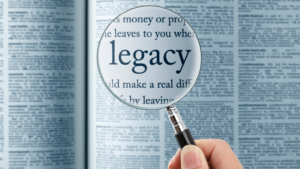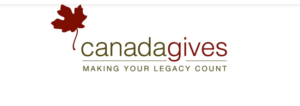
By Steve Lowrie, CFA
Special to the Financial Independence Hub
Most posts about legacy, wills, and estate planning focus on how to settle your estate after you pass: ensuring your intentions are met, your family is cared for, charitable gifts are fulfilled, taxes are minimized, and so on.
Estate planning is important; we help clients with it all the time. But today, I’d like to offer a valuable twist on the theme of estate, life, and legacy planning:
Instead of your excess wealth being distributed after you die, you may find even greater value in giving some of it away while you’re still around.
Properly managed, making gifts and charitable donations while you’re alive can offer solid tax-saving benefits to you and your estate financial planning. In particular, targeted charitable giving can be a powerful tool for business owners and similar professionals who are approaching retirement and facing high-tax events, such as selling their business, or exercising highly appreciated stock options.
As importantly, it can be incredibly rewarding to witness the results of your generosity. Don’t underestimate the value this intangible benefit can add to your life and legacy planning.
Legacy Planning for Quality Living
First, what is “excess wealth?” Is there such a thing as too much money??? Not really.
This is where legacy planning is essential. If you’re thinking about spending, gifting, or donating significant wealth, don’t just guess at the dollar amounts. Instead, you and your financial advisor should periodically crunch the numbers to determine how much you and your loved ones conservatively need to remain well-positioned, even under worst-case scenarios (such as, say, a global pandemic).
After that — if you and your loved ones are indeed set for life — any extra resources become the financial equivalent of gravy on your entrée. How will you use your excess wealth to add flavour to your life and to the lives of others so that you are leaving a legacy you can be proud of?
An anecdote about Lifetime Charitable Giving
To envision what it would be like to make one or more significant charitable donations during your lifetime, consider the story of “John and Jane,” an earnest couple in their 60s who came to me for advice a few years ago. John came from meager roots, but he was determined to make his own way. With a boost from some financial aid, he put himself through college, where he met Jane. Together, they worked hard, scrimped and saved, and raised two kids. Along the way, John started his own business, which prospered.
Fast forward to 2020, when John was able to sell his business for a substantial sum of money. After we ran all the numbers, it was clear he, Jane, and even their kids would be able to live comfortably for their remaining days. Both personally and in a holding company, the couple also owned some taxable investments that had appreciated nicely.
So far, so good. However, there was one challenge (even if it was a nice “problem” to have): even with extensive planning in the anticipation of an eventual sale (purified operating company, multiplying the lifetime capital gain exemption, etc.), the business buy-out would generate hundreds of thousands of dollars in taxes in the year of the sale. As the saying goes, when you’ve incurred taxable gains, you can choose who’s going to benefit the most from the taxable portion: the government, or your favorite charities. I suggested to John and Jane, they could reduce their taxes owed in the year of the sale by instead fulfilling some of their existing charitable intents that same year.
To manage the significant donation they had in mind, we established a Donor-Advised Fund (DAF) in their name. They then donated into their DAF an equal amount to the taxes incurred from the sale of John’s business. This helped them accomplish several goals:
- They were able to fully offset the taxable buy-out gains with their charitable contribution.
- John was able to fulfill a lifelong dream by using some of the DAF assets to establish a scholarship at his alma mater. By doing so during his lifetime, he has been able to see others benefiting from a solid education, just as he had when he was young. On a personal level, he and Jane have found the experience highly rewarding.
- Moving forward, they can donate highly appreciated assets to their DAF to wash away those gains as well.
A DAF offers a few other benefits as well. For example, you can direct how to invest undistributed DAF dollars in the market, potentially increasing your giving power over time. You can also keep your charitable giving anonymous if you’re so inclined.
Want to learn more about DAFs? Canada Gives offers additional information about Donor-Advised Funds, as well as this helpful video on the subject:
Spending on Loved Ones
Whether or not you’re charitably inclined, you may also want to apply similar concepts to gift-giving to your kids, grandkids, or other important people in your life. You could wait until you’re gone and leave them an inheritance. Or you could start to share excess wealth while you are still around to see your loved ones’ faces light up when they receive your gift.
For example, instead of leaving your children or grandchildren $1 million to inherit later, you could instead give them $10,000 annually for a decade, help them fund their first home, pay for their higher education, travel together as a family, and so on.
Gifting doesn’t offer as many tax benefits as does charitable giving. But there are tax angles to consider when gifting while you’re alive versus leaving an inheritance. For example, if you’re sitting on excess wealth in the form of highly appreciated assets, you may prefer to sell them now, pay the taxes, and give the after-tax proceeds to your kids. This can create a lighter tax burden for your estate and/or your heirs later.
Once you’ve sorted out your preferred gift-giving logistics, the excitement of watching a loved one making good use of your excess wealth can be incredibly heartwarming. Conversely, sometimes a relatively modest gift may turn into a disappointment. What if your gift goes unappreciated or is senselessly squandered? This too can inform you about your future gifting priorities—before it’s too late to do anything about it.
Part of the Life and Legacy Planning
Even if you can readily afford to do so, charitable giving and/or family gifting isn’t for everyone. For any number of reasons, you may prefer to retain full ownership of your wealth while you’re alive. Legacy estate planning services can then sort out the excess after you’re gone. This will be less work for you!
Either way, one thing is for sure (and I don’t say that very often): You can’t take it with you.
Whether you’d rather distribute your excess wealth personally, or let others settle your estate, the key ingredient to building and leaving a legacy is to complete some legacy planning.
- How much can you afford to give?
- How much do you want to give, and to whom?
- How can you make your gift as meaningful and tax efficient as possible?
Through careful life and legacy planning, your legacy can become an extension of the values you’ve held throughout your life. In that sense, perhaps it’s possible to leave behind something far more substantial than money alone has to offer.
 Steve Lowrie holds the CFA designation and has 25 years of experience dealing with individual investors. Before creating Lowrie Financial in 2009, he worked at various Bay Street brokerage firms both as an advisor and in management. “I help investors ignore the Wall and Bay Street hype and hysteria, and focus on what’s best for themselves.” This blog originally appeared on his site on Jan. 25, 2022 and is republished here with permission.
Steve Lowrie holds the CFA designation and has 25 years of experience dealing with individual investors. Before creating Lowrie Financial in 2009, he worked at various Bay Street brokerage firms both as an advisor and in management. “I help investors ignore the Wall and Bay Street hype and hysteria, and focus on what’s best for themselves.” This blog originally appeared on his site on Jan. 25, 2022 and is republished here with permission.



